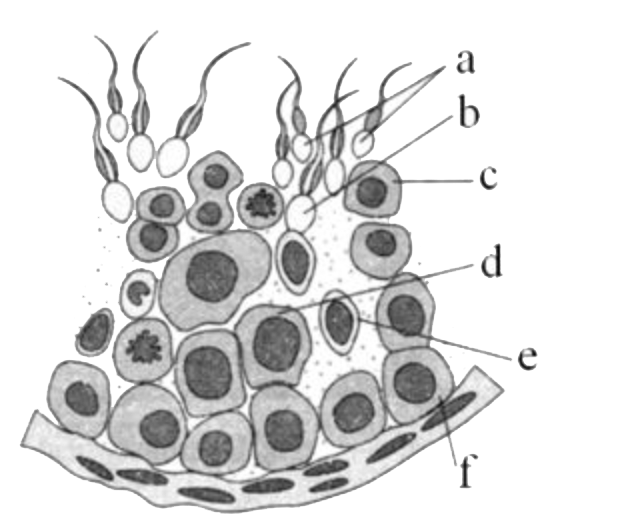Which pair of cells appear during the process of spermatogenesis?
(a) Spermatogonia, sperm lysin
(b) Oocyte, Spermatozoa
(c) Spematid, Primordial follicle
(d) Spermatogonia, Spermatozoa
Spermatogonia, sperm lysin
Oocyte, Spermatozoa
Spematid, Primordial follicle
Spermatogonia, Spermatozoa
The correct Answer is:D
To solve the question regarding which pair of cells appear during the process of spermatogenesis, we will analyze each option provided:
1. Understanding Spermatogenesis:
- Spermatogenesis is the process of sperm formation that occurs in the male reproductive system. It involves several stages starting from spermatogonia (the initial germ cells) and ending with spermatozoa (mature sperm cells).
2. Analyzing the Options:
- Option (a): Spermatogonia, sperm lysin
- Spermatogonia are indeed the initial cells in spermatogenesis, but sperm lysin is not a cell involved in this process. Therefore, this option is incorrect.
- Option (b): Oocyte, Spermatozoa
- Oocytes are female germ cells and are not involved in spermatogenesis, which is a male-specific process. Thus, this option is incorrect.
- Option (c): Spermatid, Primordial follicle
- Spermatids are formed during spermatogenesis, but primordial follicles are structures found in the ovaries and are not related to spermatogenesis. Therefore, this option is incorrect.
- Option (d): Spermatogonia, Spermatozoa
- Spermatogonia are the starting cells in spermatogenesis, and spermatozoa are the end products of this process. This option correctly identifies both types of cells involved in spermatogenesis.
3. Conclusion:
- After analyzing all the options, the correct answer is (d) Spermatogonia, Spermatozoa.
- Spermatogenesis is the process of sperm formation that occurs in the male reproductive system. It involves several stages starting from spermatogonia (the initial germ cells) and ending with spermatozoa (mature sperm cells).
- Option (a): Spermatogonia, sperm lysin
- Spermatogonia are indeed the initial cells in spermatogenesis, but sperm lysin is not a cell involved in this process. Therefore, this option is incorrect.
- Option (b): Oocyte, Spermatozoa
- Oocytes are female germ cells and are not involved in spermatogenesis, which is a male-specific process. Thus, this option is incorrect.
- Option (c): Spermatid, Primordial follicle
- Spermatids are formed during spermatogenesis, but primordial follicles are structures found in the ovaries and are not related to spermatogenesis. Therefore, this option is incorrect.
- Option (d): Spermatogonia, Spermatozoa
- Spermatogonia are the starting cells in spermatogenesis, and spermatozoa are the end products of this process. This option correctly identifies both types of cells involved in spermatogenesis.
- After analyzing all the options, the correct answer is (d) Spermatogonia, Spermatozoa.
Similar Questions
Correct sequence of spermatogenesis :
(a) spermatogonia
(b) spermatids
(c) primary spermatocyte
(d) secondary spermatocyte
(e) spermatozoa
View SolutionArrange in correct sequence the structures formed during spermatogenesis
a) spermatogonia
b) Secondary spermatocyte
c) Spermatogonial stem cells
c) spermatogonial stem cell
d) primary spermatocyte
e) spermatid
View Solution
Knowledge Check
Consider the following statements each with two blanks.
(A) Seminiferous tubules produce (i)_____ while Leydig's cells produce (ii)_____.
(B) In females, urethra is small and conducts (iii)_____ while in males it conducts urine and (vi)_____.
(C) The process of formation of spermatozoa form spermatogonia is called (v)_____ and the process of maturation of spermatids into spermatozoa is called (vi)_____.
Which one of the following options, gives the correct fill ups for the respective blanks numbers from (i) to (vi) in the statements?A(i)-spermatozoa, (ii)-testosterone,
(v)-spermatogenesis, (vi)-spermiogensisB(i)-testosterone, (ii)- spermatozoa,
(iii)-urine, (iv)-semenC(i)-estrogen, (ii)-testosterone,
(v)-spermiogenesis, (vi)-spermatogenesisD(iii)-urine, (iv)-semen,
(v)-spermiogenesis, (vi)-spermatogenesis
Which of the following undergoes spermiogenesis :
(a) Spermatids
(b) Spermatogonia
(c) Primary spermatocytes
(d) Secondary spermatocytes
View SolutionProcess of maturation and development of sperms is
(a) Spermatogenesis
(b) Spermiogenesis
(c) Oogenesis
(d) Spermiation
View SolutionRecognize the figure and find out the CORRECT labeling.

(a) a -spermatozoa, b - spermatid, c - primary spermatocyte , d - secondary spermatocyte , e - spermatogonia , f - sertoli cell
(b) a -spermatozoa, b - spermatid, c - secondary spermatocyte , d - primary spermatocyte - Sertoli cell , f - spermatogonia
(c) a -spermatozoa, b - spermatid, c - primary spermatocyte , d - secondary spermatocyte , e - spermatogonia , f - sertoli cell
(d) a -spermatozoa, b - spermatid, c - secondary spermatocyte , d - primary spermatocyte - Sertoli cell , f - spermatogonia
View SolutionDuring spermatogenesis how many spermatozoa are formed from a single primary spermatocyte?
(a) 1
(b) 2
(c) 4
(d) 8
View SolutionSpermiogenesis is a process in which :-
(a) spermatids change into spermatozoa
(b) spermatogonia produce a spermatid
(c) spermatocytes give rise to spermatozoa
(d) dormant spermatozoa become active just before ejaculation
View SolutionWhich of the following is incorrect about spermatogenesis?
(a) Meiosis-l leads to the formation of secondary spermatocytes
(b) Meiosis-II leads to the formation of spermatids
(c) Production of one sperm and 3 polar bodies
(d) Primary spermatocytes are diploid in nature
View SolutionWhich hormone level reaches peak during luteal phase of menstrual cycle?
(a) Luteinising hormone
(b) Progesterone
(c) Follicle stimulating hormone
(d) Estrogen
View Solution
